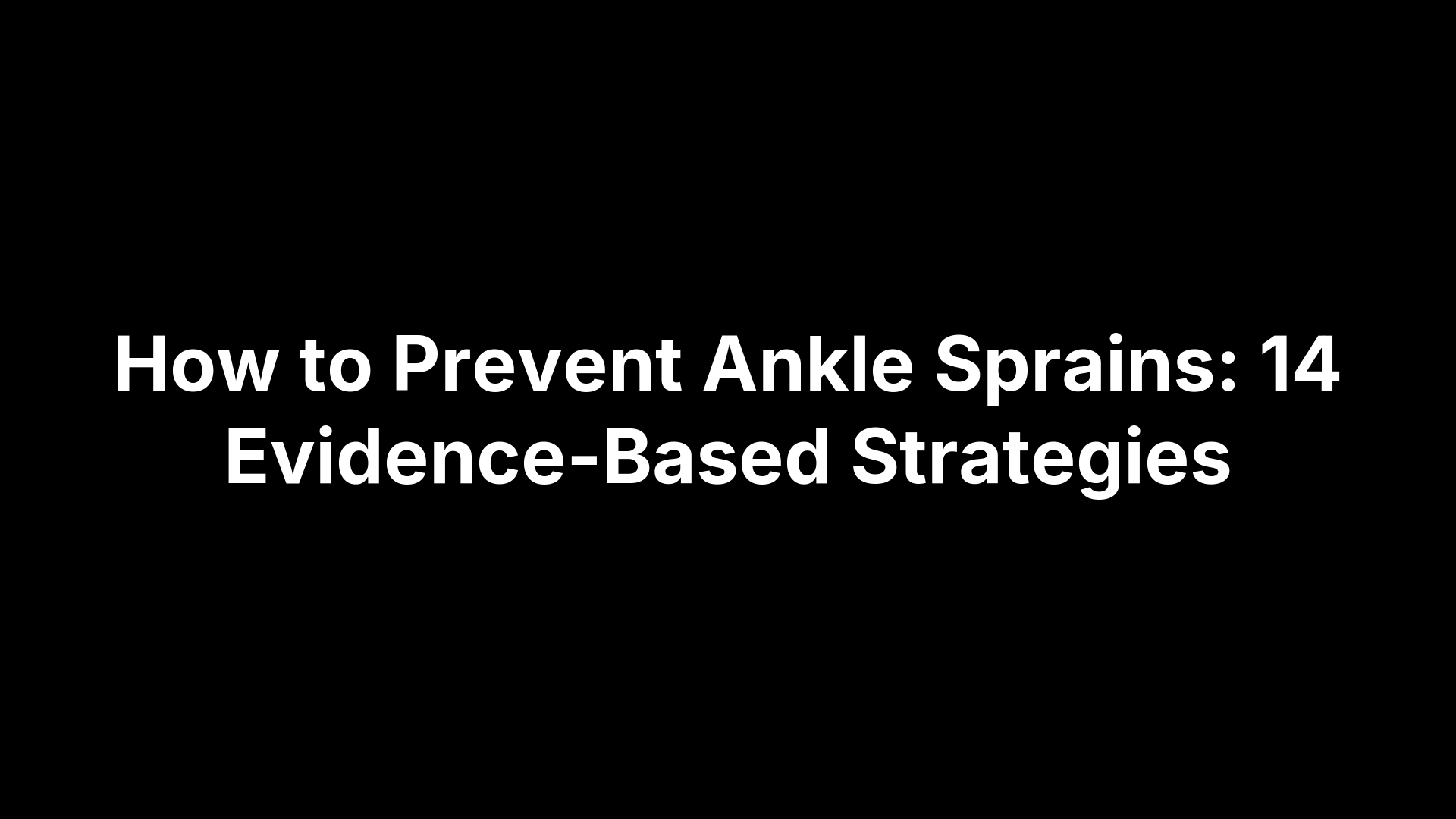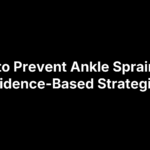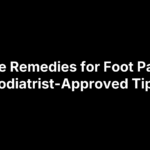Pain, swelling, and that uneasy wobble—an ankle sprain can turn the simplest step into a chore. The quickest path to relief starts within the first hour: stop weight-bearing, wrap snugly, ice 15-20 minutes, elevate above heart level, and line up a podiatry review. This updated R.I.C.E.R. routine keeps swelling down and kick-starts healing.
An ankle sprain isn’t just a twist; it’s a stretched or torn ligament. Handle it poorly and you court chronic instability—treat it properly and many grade-I injuries are jogging again in two weeks. This guide shows you how: gauge severity, nail the first 48 hours, restore motion, rebuild strength, protect the joint, and recognize red-flag symptoms.
Keep this page close—skip ahead for quick answers or follow along step by step to return to walking, running, and sport with confidence. Every recommendation draws on current sports-medicine research and the hands-on experience of foot and ankle specialists.
Gauge the Severity: Is It a Mild Twist or a Serious Sprain?
Before you Google yet another hack on how to treat a sprained ankle, pin down what you’re dealing with. Severity drives every decision—from whether you can self-manage with an elastic wrap to whether you need an X-ray and a walking boot. Spend two minutes on the checks below and you’ll avoid the two biggest recovery killers: under-treating a serious sprain and over-resting a minor one.
Recognize Sprain Grades (I, II, III)
| Grade | What Happened to the Ligament | Pain & Swelling | Bruising Pattern | Walking Ability | Avg. Return to Sport |
|---|---|---|---|---|---|
| I | Stretched, fibers intact | Mild, localized | Little to none | Limp but can bear weight | 2–3 weeks |
| II | Partial tear | Moderate, spreads into foot | Purple/blue after 24 h | Difficult; often needs crutches | 6 weeks |
| III | Complete tear | Severe, immediate ballooning | Deep purple within hours | Unable to bear weight | 10–12 weeks+ |
Key clues: the more rapid and diffuse the swelling, the higher the grade. A “pop” at injury often signals Grade II or III.
Rule Out Fracture or High Ankle Sprain
Use the Ottawa Ankle Rules:
- Press the back edge of each malleolus (ankle bone). Sharp bone tenderness? Get an X-ray.
- Can’t take four pain-limited steps right after injury and in the clinic? Imaging time.
Red-flag fracture signs: obvious deformity, numb toes, skin tenting.
High ankle (syndesmotic) sprain red flags:
- Pain above the ankle joint, especially when you try to point the knee over the toes (dorsiflex).
- Squeeze test: pain when you compress the tibia and fibula mid-calf.
Missing either injury delays healing and sets the stage for arthritis.
Decide on Home Care vs Urgent Medical Attention
Seek same-day professional care if you notice:
- Severe or increasing pain despite rest and ice
- Foot looks crooked or feels unstable
- Numbness, tingling, or cold toes
- Open wound, bleeding, or you have diabetes or vascular disease
- History of repeated sprains or you’re an athlete in-season
Everyone else can start R.I.C.E.R. at home, but book a prompt podiatry visit for tailored bracing and a rehab roadmap—you’ll shave days off your downtime.
Act Fast in the First Hour: The Updated R.I.C.E.R. Protocol
The “golden hour” after an ankle sprain sets the tone for the next six weeks. Cap swelling early and you shorten total healing time; let fluid pool and the ligament bathes in chemicals that stiffen tissue and slow repair. Think of R.I.C.E.R. as your emergency checklist for how to treat a sprained ankle before you even think about a doctor’s waiting room.
Rest Without Delay
- Stop the activity immediately—no heroic “walk it off” moments.
- Sit or lie down and unlace the shoe to avoid a tourniquet effect.
- If standing hurts more than a 3/10, recruit crutches or a friend’s shoulder so the injured foot stays in the air.
Ice for 15–20 Minutes On, 90 Minutes Off
- Fill a zip-top bag with ice or grab a bag of frozen peas.
- Place a thin towel between skin and ice; direct ice on skin risks frostbite.
- Set a timer for 15 minutes (20 max), then remove.
- Wait 90 minutes before the next round; repeat 3–4 times in the first six hours.
Skin should look pink, never white or gray—check every five minutes.
Compression That’s Snug but Not Numbing
A figure-of-eight elastic wrap keeps swelling in check.
- Start at the ball of the foot, wrap toward the calf with 50 % overlap.
- Tension test: you should slip two fingers under the bandage easily.
- If toes tingle or turn blue, unwrap and redo with lighter pull.
- Overnight: light compression is fine; re-wrap fresh in the morning.
Elevation Above Heart Level
Gravity is free lymphatic drainage. Prop the ankle:
- On three pillows while lying flat
- On a stack of textbooks under your desk
Aim for 20–30° above the heart; the higher the limb, the faster fluid exits.
Referral (the “R” in R.I.C.E.R.)
Even if pain eases, an early podiatry check pays dividends:
- Rapid imaging rules out hidden fractures or high ankle sprain.
- A purpose-built brace replaces guess-and-check wrapping.
- A written rehab plan prevents the “felt better, reinjured it” loop.
Book the visit within 24 hours—fast professional guidance is part of truly fast recovery.
Control Pain and Swelling Over the First 48 Hours
The next two days decide whether your ankle balloons like a grapefruit or settles into a manageable ache. Effective swelling control keeps fresh blood flowing in and cellular debris moving out—essential steps in how to treat a sprained ankle quickly. Combine smart medication, timed cold-compression cycles, early motion, and nutrient support to create the ideal healing environment.
Medications and Topicals That Actually Help
| Drug | Single Dose | Max / 24 h | Notes |
|---|---|---|---|
| Ibuprofen | 400–600 mg | 2 400 mg | Take with food; avoid if you have ulcers or kidney disease |
| Naproxen | 220 mg | 1 000 mg | Longer-acting; dose every 8–12 h |
| Acetaminophen | 500–650 mg | 3 000 mg | Pain relief without anti-inflammatory effect; safe if you can’t take NSAIDs |
Alternate acetaminophen with an NSAID for round-the-clock coverage. Topical NSAID gels (diclofenac 1 %) reduce surface inflammation with fewer stomach issues—massage a thin layer three times a day.
Continue Cryotherapy and Compression Cycles
| Time Post-Injury | Ice / Compression Plan |
|---|---|
| 0–6 h | 15 min on, 90 min off; re-wrap after each round |
| 6–24 h | 15 min every 3 h; loosen wrap as swelling drops |
| 24–48 h | 15 min, 4–5×/day; switch to ankle sleeve if bandage feels loose |
Check cap refill in toes; if color doesn’t return in 2 sec, unwrap and redo.
Gentle Toe and Foot Pumps to Prevent Stiffness
Start moving within the wrap: spell the alphabet with your big toe, pump the ankle up and down, and curl/extend toes—10 reps each hour you’re awake. Work only into mild discomfort; sharp pain means back off.
Nutrition and Hydration to Support Healing
Aim for protein (g) = body_weight(lb) × 0.8–1. Include vitamin-C-rich fruit, leafy greens for vitamin K, and 1 000 IU vitamin D if sun exposure is limited. Stay hydrated—clear urine is your daily litmus test—and skip alcohol or tobacco, both proven inflammation accelerators.
Restore Mobility Safely: Gentle Range-of-Motion Exercises
If the first 48 hours were about putting the fire out, the next step is opening the windows—getting the joint moving so scar tissue doesn’t glue everything together. Light, pain-limited motion sends fresh nutrients to the injured ligament and reminds the brain how a normal stride feels. Follow the progression below; it bridges the gap between rest and strength work without re-inflaming the ankle.
When Is It OK to Walk on a Sprained Ankle?
Use the “3-out-of-10 rule.” If standing or taking a step hurts no more than a 3/10 and swelling doesn’t increase afterward, you’re clear for partial weight-bearing. Most grade-I sprains hit this milestone within 24–72 hours; grade-II may need a walking boot or crutches longer. Start with heel-touch walking around the kitchen counter, advance to full foot contact, then normal gait. Check the ankle that evening—new swelling means you did too much.
Ankle Alphabet and Circles
Sit with the leg supported and draw the entire alphabet in the air using your big toe as the “pen.” Keep the motion smooth; stop at the first stab of pain. Follow with 20 slow circles clockwise and 20 counter-clockwise. Perform 2–3 sets, 2–3 times per day. Multidirectional sweeping loads the ligament fibers at varied angles, laying down stronger collagen than straight-line pumps alone.
Seated and Standing Calf Stretches
Tight calves limit ankle dorsiflexion and force you to limp. Twice daily:
- Seated towel stretch: loop a towel around the ball of the foot, keep knee straight, and gently pull until you feel a calf stretch. Hold 20–30 seconds, repeat three times.
- Wall stretch: lean into a wall with the injured leg behind, heel flat, knee straight. Hold 20–30 seconds, three reps.
Maintain steady pressure—bouncing invites micro-tears.
Common Mistakes That Slow Recovery
- Pushing through sharp pain or swelling “because the game is Saturday.”
- Only moving the ankle up and down; skipping side-to-side motion.
- Keeping the brace so tight during exercises that circulation suffers.
- Total immobilization past 72 hours—over-protecting is just as harmful as over-doing.
Avoid these traps and your range-of-motion work will fast-track the rest of your plan for how to treat a sprained ankle and get back on your feet.
Rebuild Strength and Balance to Prevent Re-Injury
Once swelling is down and motion is back, the focus shifts to making the ankle tougher than it was pre-sprain. Strong muscles absorb impact, and sharp balance reactions stop those awkward rolls that lead to repeat injuries. Expect this phase to run in parallel with daily life—you’ll squeeze in short sets, not marathon gym sessions, and feel steady gains each week.
Resistance Band Exercises
Start seated with a light-to-medium resistance band looped around the forefoot:
- Plantarflexion (push away)
- Dorsiflexion (pull toward you)
- Inversion (sole in)
- Eversion (sole out)
Perform 3 × 10–15 slow reps for each movement, pausing two seconds at the end range. Increase band tension or add a fourth set when all reps feel easy and pain-free.
Weight-Bearing Strength Work
Gravity adds functional load you can’t fake with bands.
- Double-leg heel raises → single-leg heel raises
- Mini squats to a chair
- 6-inch step-ups, forward then lateral
Progress only when you can complete 20 reps without a hitch of pain or wobble. Keep a chair nearby for balance the first few days.
Proprioception and Balance Drills
Ligaments contain nerve endings that act like motion sensors; sprains scramble their signal. Retrain them:
- Barefoot single-leg stand, eyes open 30 sec
- Advance to standing on a folded towel, then a wobble board
- Star excursion: reach the free foot forward, side, and back while the injured leg stays planted
Aim for two minutes of balance work, twice daily.
Gradual Return to Running and Sports
Follow a four-step ladder, moving up only if the ankle stays swell-free the next morning:
- Fast walk 10 min
- Jog 5 × 1 min with 1 min walk breaks
- Run straight 15 min, steady pace
- Add cuts, pivots, and stop-starts in short drills
Any spike above a 3/10 pain or new puffiness? Drop back one level for 48 hours. Stick with this measured progression and you’ll log pain-free miles instead of repeat ER visits.
Protect the Healing Ligament: Bracing, Taping, and Footwear Tips
Swelling is down and you’re walking better, but the ligament is still knitting itself together. External support buys you time: it limits risky motion while letting the surrounding muscles fire normally. Think of the gear below as scaffolding—temporary, adjustable, and crucial for avoiding the dreaded “second sprain.”
Choosing the Right Ankle Brace
- Lace-up sleeve: flexible, fits in most shoes, good for daily wear and desk jobs; costs $20–$30.
- Semi-rigid stirrup: plastic side panels, laces or Velcro straps; blocks side-to-side wobble, ideal for court sports; $40–$60.
- Walking boot: total immobilization, used only until pain <3/10 with weight bearing.
Move from boot → semi-rigid → lace-up as pain and confidence improve. During high-risk play, keep the brace on for six months to cut re-injury rates in half.
How to Tape Your Ankle Like a Pro
Materials: 1.5-inch athletic tape, optional pre-wrap.
- Anchor strips above ankle.
- Figure-of-eight wrap, crossing over the foot arch.
- Heel-locks on each side to stop inversion.
- Finish with two anchors.
Tension check: skin should stay pink; remove if tingling starts. Re-tape before every practice or game.
Supportive Shoes and Orthotics
Choose footwear with a firm heel counter, cushioned midsole, and low (≤10 mm) heel drop. Over-pronators benefit from prefab or custom orthotics that keep the heel vertical and unload overstretched ligaments, especially during long shifts or runs.
Nighttime Care: Should You Wrap a Sprained Ankle Overnight?
A light elastic wrap—snug enough to indent the skin but not cut circulation—keeps morning puffiness at bay. Loosen tension by half, elevate the foot on a pillow, and inspect the skin for redness first thing next day. If numb, skip the wrap.
Know When Professional Help Is Essential
Most ankle sprains heal with diligent home care, yet roughly one in five morphs into chronic instability because the underlying injury was bigger than it looked. Save yourself months of limping by recognizing the limits of DIY rehab and looping in a podiatry specialist at the right moment.
Warning Signs Your Sprain Isn’t Healing
- Swelling or bruising that doesn’t shrink after 7 days
- Ankle “gives way” when you pivot or go downstairs
- Can’t rise onto toes without sharp pain
- Numbness, tingling, or foot cold to the touch
- Fever or red streaks (possible infection)
Any single item warrants an appointment within 24 hours.
Imaging and Diagnostic Options
- X-ray: rules out hidden fractures; covered by most insurance
- Ultrasound: real-time look at ligament fibers; quick and painless
- MRI: gold standard for full tears or cartilage damage; useful if surgery is on the table
Early imaging fine-tunes your rehab load and brace choice.
Advanced Treatments to Accelerate Recovery
- Physical therapy modalities: therapeutic ultrasound, laser, electrical stimulation
- Injections: platelet-rich plasma (PRP) for stubborn grade-II/III sprains; corticosteroid rarely for acute swelling
- Surgery: ligament repair or reconstruction when complete tears leave the joint unstable
What to Expect at a Podiatry Appointment
History, gait check, and hands-on tests (anterior drawer, talar tilt) pinpoint laxity. You’ll leave with:
- A custom brace or boot
- Printed exercise progressions
- A follow-up timeline to ensure the ligament knits tight
Professional guidance transforms “how to treat a sprained ankle fast” from guesswork into a proven plan.
Timeline Expectations: How Long Until I Can Walk, Jog, and Play Sports?
The biggest mental hurdle after an ankle sprain is not knowing when normal life resumes. While every body heals at its own pace, decades of sports-medicine data give us solid benchmarks. Use the timelines below as guide rails—not rigid deadlines—to pace your rehab and spot trouble early. If progress stalls for more than a week, circle back to your podiatrist to fine-tune the plan.
Average Recovery Times by Sprain Grade
| Grade | Walk Pain-Free | Start Jogging | Full-Speed Sport |
|---|---|---|---|
| I | 5–7 days | 10–14 days | 2–3 weeks |
| II | 1–2 weeks | 3–4 weeks | ~6 weeks |
| III | 2–3 weeks PWB | 6–8 weeks | 10–12+ weeks |
PWB = partial weight-bearing with crutches or boot.
These ranges assume you’ve followed the R.I.C.E.R. protocol, maintained compression, and progressed through mobility and strength drills without flare-ups.
Day-by-Day Milestones for the First Week
| Day | Swelling Goal | Pain Target (0–10) | ROM Target | Weight-Bearing |
|---|---|---|---|---|
| 1 | –10 % | ≤6 | Pumps only | None |
| 2 | –20 % | ≤5 | Alphabet | Heel-touch |
| 3 | –30 % | ≤4 | Circles | Flat-foot with aid |
| 4 | –40 % | ≤3 | 20° dorsiflex | Unassisted indoors |
| 5 | –50 % | ≤3 | Full alphabet | Short outdoor walks |
| 6 | –60 % | ≤2 | Near-full | Normal gait practice |
| 7 | –70 % | ≤2 | Full | Brace only for comfort |
Hitting—or beating—these mini-targets usually keeps you on track for the broader grade-I and grade-II timelines.
Managing Setbacks and Plateaus
Progress rarely runs in a straight line. Common speed bumps include overdoing weekend chores, skimping on sleep, or forgetting band work. If pain or swelling jumps a level, drop back to the previous exercise stage for 48 hours and restart. Keep a brief log of activities, pain scores, and swelling; patterns make it easier for your clinician to adjust loading or add treatments like physical-therapy modalities. Celebrate small wins and remember: smart pacing is the real shortcut to full-speed play.
Step Forward with Confidence
Fast relief isn’t luck—it’s a series of smart moves you now have in your back pocket. Lock down swelling with R.I.C.E.R. in the first hour, load the joint only when pain is low, and follow a steady diet of motion, strength, and balance drills. Keep the ankle supported with the right brace or tape until the ligament has remodelled, and don’t shrug off warning signs that call for imaging or a specialist’s eye.
If you live in Central Virginia and want a recovery plan tailored to your exact injury and lifestyle, book a same-day visit with the team at Achilles Foot and Ankle Center. Heal right, return strong, and walk away confident.






